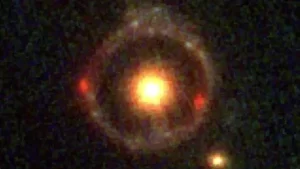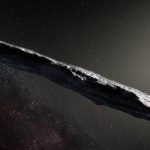Key Takeaways:
- The James Webb Space Telescope (JWST) has captured an extraordinary image of the farthest-known Einstein ring, a gravitational lensing phenomenon.
- This Einstein ring is a remarkable 21 billion light-years away and encircles a densely packed galaxy.
- Gravitational lensing, predicted by Einstein’s theory of relativity, occurs when massive foreground objects warp space-time, causing distant objects’ light to curve and magnify.
- Most lensed objects appear as arcs or partial rings, but a genuine Einstein ring forms a complete circle, a rare alignment.
- The newly discovered Einstein ring, called JWST-ER1, helps estimate the lensing galaxy’s mass, revealing its exceptional density and posing mysteries about its composition.

In an astonishing cosmic revelation, the James Webb Space Telescope (JWST) has unveiled the farthest Einstein ring ever observed, marking a breakthrough in our understanding of gravitational lensing phenomena. This unprecedented discovery, made possible by the JWST’s advanced capabilities, showcases an Einstein ring located an astounding 21 billion light-years away, enveloping a mysteriously dense galaxy.
Einstein rings, a rare class of gravitationally lensed objects, were originally envisioned by Albert Einstein’s theory of relativity. Gravitational lensing occurs when an immensely massive foreground entity, like a galaxy cluster or black hole, distorts space-time around it. Consequently, light from more distant celestial objects, such as galaxies or supernovas, passing through this distorted space-time, appears curved and warped when observed from Earth.
This gravitational effect not only distorts but also amplifies the light of the lensed object, analogous to the magnifying glass principle. This magnification allows astronomers to scrutinize distant objects with greater precision than conventionally possible. While most gravitationally lensed objects typically manifest as arcs or partial rings encircling the foreground object, true Einstein rings are exceedingly rare and form complete circles. This unique alignment necessitates perfect positioning of the distant object, foreground object, and the observer.
A recent study, available on the preprint server arXiv and soon to be published in the journal Nature Astronomy, introduces the awe-inspiring JWST-ER1. This newly discovered Einstein ring, situated within the COSMOS-Web survey, emerged from a meticulous mapping endeavor encompassing over 500,000 galaxies, realized through an uninterrupted 200-hour JWST observation.

JWST-ER1 consists of two essential components: JWST-ER1g, a compact galaxy serving as the foreground lensing object, and JWST-ER1r, the light originating from a more distant galaxy that forms the radiant ring. Impressively, JWST-ER1g is located approximately 17 billion light-years from Earth, while JWST-ER1r resides an additional 4 billion light-years distant. For context, the farthest previously detected lensing object was approximately 14.7 billion light-years away, highlighting the astonishing reach of this discovery. This disparity arises due to the universe’s ongoing expansion, causing light from the most ancient objects to traverse immense distances before reaching our telescopes.
The completeness of JWST-ER1’s ring enabled researchers to calculate the lensing galaxy’s mass by assessing the degree of space-time distortion it induced. Astonishingly, their calculations unveiled a mass equivalent to roughly 650 billion suns, an unusually high density for its size. While some of this mass can be attributed to dark matter, the mysterious and invisible substance constituting about 85% of the universe’s matter, it remains unclear what additional factors contribute to the galaxy’s exceptional mass.

The enigma deepens as scientists ponder the commonalities among these ancient, dense galaxies. Similar galaxies with comparable age and density have been detected before, sparking theories that suggest they might harbor more dark matter than expected or possess a greater population of small-mass stars compared to younger galaxies. However, further research is imperative to unravel these mysteries.
Remarkably, this isn’t the first authentic Einstein ring spotted by JWST. In September 2022, a Reddit user stumbled upon a perfectly circular ring of light originating from the galaxy JO418, located approximately 12 billion light-years away, gravitationally lensed around a closer galaxy.
Originally published on Space.com


